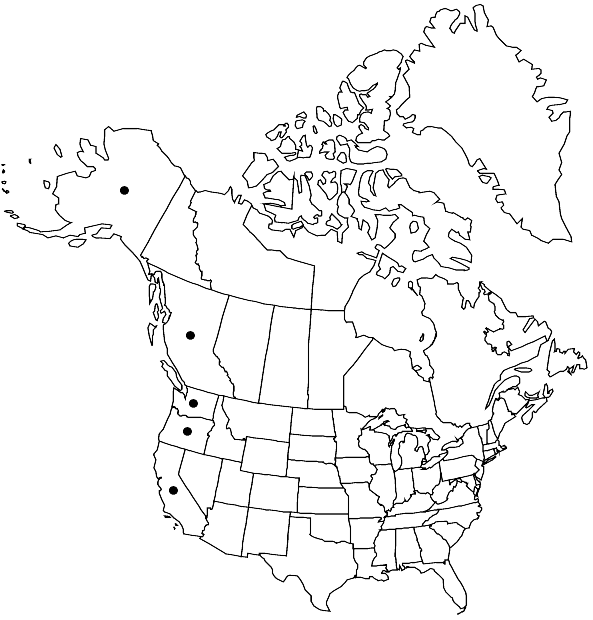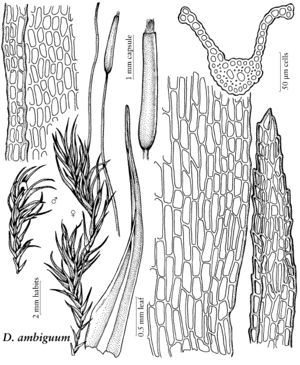Ditrichum ambiguum
Bull. Torrey Bot. Club 20: 117. 1893,.
Plants in loose to dense tufts, green to yellowish green, becoming yellowish-brown with age, dull. Stems 0.7–2 cm, with a few reddish rhizoids at the base. Leaves erect-spreading, somewhat crisped when dry, 1.5–4.5 mm, lanceolate to linear-lanceolate, channelled, lamina with a few scattered 2-stratose cells midway between margins and costa in median to distal part of leaf; margins broadly recurved from the base to near mid lamina, weakly to strongly serrulate from mid lamina to apex, entire or serrulate at the somewhat blunt apex, 2-stratose distally and sometimes extending inward for several cells; costa distinct, percurrent, occupying 1/6–1/3 the width of the leaf base; lamina cells thick-walled, distal cells quadrate, irregularly subquadrate to shortrectangular, 8–24 × 4–8 µm, becoming broader and longer near the base. Specialized asexual reproduction unknown. Sexual condition dioicous. Seta red, 1–2 cm, erect. Capsule erect, usually straight and symmetric or sometimes slightly curved, dark-brown or reddish, cylindric, 1.5–3 (–3.2) mm, occasionally slightly enlarged at base; operculum rostrate, 0.4–0.8 mm; peristome red, 200–500 (–800) µm, twisted when dry, teeth divided to near base into two equal filaments, strongly papillose to spiculose. Spores round, 6–13 µm, appearing smooth to minutely papillose.
Phenology: Capsules mature spring and summer (Apr–Jul).
Habitat: Moist, sandy or sometimes clay banks, soil on upturned stumps, crevices of sandstone cliffs, often in clearings along roads
Elevation: low to moderate elevations (100-500 m)
Distribution

B.C. (including Queen Charlotte Island), Alaska, Calif., Oreg., Wash., Central America (Guatemala), Central America (Panama)
Discussion
Ditrichum ambiguum, a western species, is very close to an eastern species, D. tortuloides, but differs in the following morphological characters: stems often branched and taller, 7–20 mm compared to the shorter, 2–5 mm, usually simple stems of D. tortuloides; leaf margins broadly recurved, entire or serrulate at a somewhat blunt apex, compared to the narrowly recurved, serrate to strongly serrate margins from mid-leaf to an acute apex in D. tortuloides; leaf laminae with 2-stratose margins and occasional 2-stratose regions between the margins and the costa in the middle to distal half of the leaf, compared to the 2-stratose regions only on the margins in D. tortuloides; capsules dark brown to reddish, 1.5–3.2 × 0.2–0.5 mm, straight and symmetric to rarely slightly arcuate with an occasionally slightly swollen base, compared to the yellow or light brown, 1–2.5 × 0.2–0.3 mm, curved and asymmetric capsules often with a swollen base in D. tortuloides. The geographic ranges of the two taxa are quite disparate. The species has been reported outside North America by B. H. Allen (1994), from Guatemala and Panama.
Selected References
None.
Lower Taxa
"um" is not declared as a valid unit of measurement for this property.
